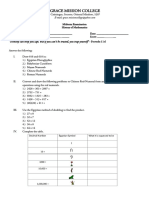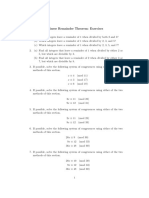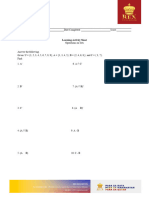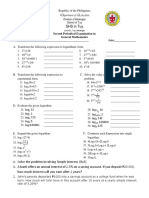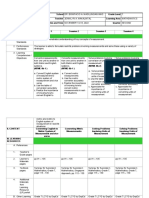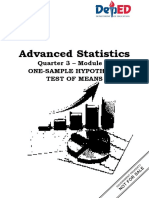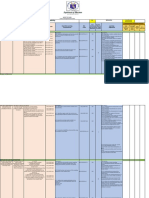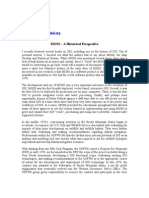Applied Statistics Syllabus
Applied Statistics Syllabus
Uploaded by
Paul Dela RosaCopyright:
Available Formats
Applied Statistics Syllabus
Applied Statistics Syllabus
Uploaded by
Paul Dela RosaOriginal Description:
Copyright
Available Formats
Share this document
Did you find this document useful?
Is this content inappropriate?
Copyright:
Available Formats
Applied Statistics Syllabus
Applied Statistics Syllabus
Uploaded by
Paul Dela RosaCopyright:
Available Formats
Republic of the Philippines
Laguna State Polytechnic University
Province of Laguna
College of Food Nutrition and Dietetics
An Outcome-Based Learning Program
1. UNIVERSITY
VISION: The Laguna State Polytechnic University is a center of sustainable development initiatives transforming lives and communities.
MISSION: LSPU provides quality education through responsive instruction, distinctive research, and sustainable extension and production services for
improved quality of life towards nation building.
QUALITY POLICY: LSPU delivers quality education through responsive instruction, distinctive research, sustainable extension and production services.
Thus, we are committed with continual improvement to meet applicable requirements to provide quality, efficient and effective services to the
university stakeholders’ highest level of satisfaction through an excellent management system imbued with utmost integrity, professionalism and
innovation.
AN OUTCOMES-BASED LEARNING PROGRAM (Syllabus)
Program: Bachelor of Science in Food Technology Academic Year: 2020-2021
Course Title: Applied Statistics (Food Science) Semester: Second Summer: ______
Pre-Requisites: No. of Units: __ 3_ No. of Hours 54
hrs.
Part 1. Course Description
This course covers statistical methods for food science which begins with the basics and terminology, nature of data and their collection, descriptive
statistics, analysis of differences – significance testing, types of significance and test, association, correlation and regression, experimental design, sensory
consumer data, instrumental data, food product for formulation, statistical quality control and lastly the multivariate applications.
Part 2. Outcomes-based Macro Curriculum Framework
Intended Learning Outcomes (ILOs)
Program Intended Course Intended
Institutional (ILOs)
Learning Outcomes Learning Outcomes
LSPU Graduate Attributes When you have fully completed the Bachelor of When you have fully completed the Math 221
Science in Food Technology, you should be Applied Statistics, you should be graduates
LSPU-ACAD-SF-015 Rev 1 17 April 2018
LSPU Graduates is expected to be a: graduates who: who:
INTEGRITY 1. Responsible and Upright Citizen, who is 1. Understand and apply the principles a. Identify the problem and
capable of achieving high level personal and various facets of food appropriate analytical
well-being contributive to the harmony technology, including sensory technique.
and betterment of the profession, evaluation in practical situation,
family, society, and nation. problem-solving and environmental
I. Professionally Skilled, who applies 3. Evaluate the microbiological, b. Design an Experimental
PROFESSIONALISM
technological as worker-leader in the physical, chemical, sensory and methodology for research
field of expertise apt to the global functional properties of food; and development
needs. 4. Explain the functionality of different
food ingredients and chemical
changes occurring during post-
harvest handling, preparation,
processing, packaging and storage,
including reactions involving
II. Creative and Critical Thinker, who 7. Understand and apply the principles c. Apply statistical principles
articulates and produces of engineering as they relate to to food science applications
entrepreneurial resources extended to converting agricultural commodities
families and community for to finished products;
improvement. 8. Create new product ideas, concepts
and procedures leading to innovative
INNOVATION
food technologies.
III. Competent Research Oriented 9. Demonstrate communication skills d. Analysis and interpretation
Individual, who is able to analyze facts (i.e. oral and written) that lead to e. Reporting and
methodically, discover and establish success in a food technology career dissemination to end user
new theory to use in solving problems including preparation of proposals,
and decision-making contributory to the position papers, technical reports,
sustainability of the needs of the
communicating technical information
community.
to a non-technical audience, making
formal and informal presentations.
Part 3. Curriculum Mapping
LSPU-ACAD-SF-015 Rev 1 17 April 2018
Program Outcomes
Course Intended Learning Outcome
PO 1 PO 2 PO 3 PO 4 PO 5 PO 6 PO 7 PO 8 PO 9
Identify the problem and appropriate analytical technique. I/P
Design an Experimental methodology for research and development I/P I/P I/P I/P I/P
Apply statistical principles to food science applications I/P I/P
Analysis and interpretation P/D
Reporting and dissemination to end user P/D
Legend:
I – Introduced
P – Practiced skills with supervision
D – Demonstrated skills without supervision
Part 4. Teaching and Learning Matrix
WEEK Intended Learning Outcomes
Course Contents Teaching-Learning Activities Assessment Tasks
(ILOs)
1 Internalize the significance of Orientation of the course and review Open Discussion Question and Answer
the course and their roles to of VMGO Forum
achieve the Vision, Mission, Discussion of the curriculum
Goals and Objectives of LSPU.
2 ILO 1, 2, 3 I. Basics and Terminology Power point Recitation
A. Introduction presentation
B. The importance of (lecture)
Statistics
C. Applications of
Statistical
Procedures in Food
Science
D. Focus and
Terminology
LSPU-ACAD-SF-015 Rev 1 17 April 2018
3 ILO 1, 2, 3, 4, 5 II. Introduction to Statistics Power point Quiz Recitation
A. History of Statistics presentation
B. Definition and (lecture)
Importance
C. Branches of Statistics
4-6 ILO 1, 2, 3, 4, 5 III. Data Collection Power point
A. Sources of Data presentation
B. Constants and (lecture)
Variables
C. Scales of
Measurement
D. Population and
Sample
E. Sampling Methods
and Techniques
7-8 ILO 1, 2, 3, 4, 5 IV. Data Presentation Power point
A. Stem-and-Leaf presentation
Display (lecture)
B. Textual, tabular, and
graphical form
C. Frequency
Distribution Table
D. Frequency Polygons,
and Cumulative
frequency
distribution.
9 MIDTERM EXAMINATION
10-11 ILO 1, 2, 3, 4, 5 V. Descriptive Statistics Power point Quiz
A. Measures of Central presentation Recitation
Tendency (lecture) Exam
B. Measures of Laboratory exercise
Dispersion or
Variation
C. Measures of
Location
12 ILO 1, 2, 3, 4, 5 VI. Probability Power point Quiz
A. The Fundamental presentation Recitation
LSPU-ACAD-SF-015 Rev 1 17 April 2018
Counting Principle (lecture)
B. Summation Notation Laboratory exercise
C. Factorial
D. Permutation
E. Combination
F. Basic Concept of
Probability
11-12 ILO 1, 2, 3, 4, 5 VII. Probability Distribution Power point Quiz
A. Normal Distribution presentation (lecture) Recitation
B. Binomial Distribution Laboratory exercise
C. Poisson Distribution
D. Skewness
E. Kurtosis
13-14 ILO 1, 2, 3, 4, 5 VIII. Hypothesis Testing Power point Quiz
A. Types of Hypothesis presentation (lecture) Recitation
B. Types of Errors Laboratory exercise
C. Level of Significance
D. One-tailed and Two-
tailed Tests
E. Steps in Hypothesis
Testing
15-16 ILO 1, 2, 3, 4, 5 IX. Parametric Test power point Quiz
A. Pearson Product presentation (lecture) Recitation
Moment Correlation Journal Reading
Coefficient
B. Linear Regression
C. T-test
D. Z-Test
E. Analysis of Variance
(ANOVA)
17 ILO 1, 2, 3, 4, 5 X. Non-Parametric Tests Power point Quiz
A. Chi-square Analysis presentation (lecture) Recitation
B. Spearman rank order Laboratory exercise Exam
Correlation
LSPU-ACAD-SF-015 Rev 1 17 April 2018
18 FINAL EXAMINATION
Part 5. References
Students’ Handbook
Bower, J.A. (2013). Statistical Methods for Food Science. Published by John Wiley & Sons, Ltd. ISBN 978-1-118-54164-7 (softback :
alk. paper) – ISBN 978-1-118-54159-3 – ISBN 978-1-118-54160-9 (epdf) – ISBN 978-1-118-54161-6 (emobi) – ISBN 978-1-118-54162-3
(epub) 1. Food–Research–Statistical methods.
Roman, A. (2015). Fundamentals of Statistics for Research
Materials
Laptop
Projector
Refrigerator
Chemical reagent
Part 6. Learners’ Assessment (Grading System)
Activity Sheets 40%
Output/Exam 40%
Class Discussion 20%
Total 100%
Part 7. Course Policies
1. Regular attendance is required for all students; three (3) unexcused absences will mean automatically dropped from the course.
2. Wearing of the University students’ ID and uniform at all times is required for all the students except when having field activities.
3. Active participation individually or in group is expected.
4. Fifteen (15) minutes of tardiness is equivalent to one (1) period of absence.
5. Student shall abide the instructor/professor’s policy on the submission of learning outputs based on the metrics and deadlines given.
Prepared by: Reviewed : Approved:
LSPU-ACAD-SF-015 Rev 1 17 April 2018
PAUL EMMANUEL P. DELA ROSA JAHZIELA S. SERRANO ERICA B. TABUAC, Ph.D.
Faculty Program Coordinator Dean, College of Food Nutrition and Dietetics
LSPU-ACAD-SF-015 Rev 1 17 April 2018
You might also like
- Dag71mb16d0 Rev.dDocument49 pagesDag71mb16d0 Rev.dMario Rodriguez JuradoNo ratings yet
- Configuration & Diagnostic Software CDSDocument27 pagesConfiguration & Diagnostic Software CDSEnrique Arce BellidoNo ratings yet
- Grace Mission College: "Honesty Can Keep You Safe, But If You Can't Be Trusted, You Trap YourselfDocument2 pagesGrace Mission College: "Honesty Can Keep You Safe, But If You Can't Be Trusted, You Trap YourselfJefferson SociasNo ratings yet
- Name: - Date: - Section: - ScoreDocument3 pagesName: - Date: - Section: - ScoreJohn Richmond CadagNo ratings yet
- Detail Lesson PlanDocument14 pagesDetail Lesson Planmaffy fernandezNo ratings yet
- Chinese Remainder Theorem: ExercisesDocument2 pagesChinese Remainder Theorem: ExercisesAmiya BiswasNo ratings yet
- Math PPT Module 5Document21 pagesMath PPT Module 5emmah macalNo ratings yet
- College of Teacher Education and Human Sciences Preliminary Exam Math in The Modern World Second Semester S.Y. 2019-2020Document1 pageCollege of Teacher Education and Human Sciences Preliminary Exam Math in The Modern World Second Semester S.Y. 2019-2020Maryjoy FerrerNo ratings yet
- Course-Syllabus Calculus1 ObeDocument7 pagesCourse-Syllabus Calculus1 ObeRigor RamosNo ratings yet
- Assessment and Evaluation in MathematicsDocument95 pagesAssessment and Evaluation in MathematicsMarnieNo ratings yet
- Mathematics in The Modern WorldDocument61 pagesMathematics in The Modern WorldEvasco, Lovely I.No ratings yet
- Learning Activity Sheet Operations On SetsDocument1 pageLearning Activity Sheet Operations On SetsJOLITA INWAY LISBOGNo ratings yet
- Measure of Central Tendency Ungrouped DataDocument31 pagesMeasure of Central Tendency Ungrouped DataJessalee Raika Dieza DaitNo ratings yet
- 2-1 Relations and FunctionsDocument31 pages2-1 Relations and FunctionsBboatb PpbblNo ratings yet
- Statistics and ProbablityDocument20 pagesStatistics and ProbablityRingo NavarroNo ratings yet
- Holy Rosary College of Santa Rosa Laguna, Inc.: Learning ModuleDocument5 pagesHoly Rosary College of Santa Rosa Laguna, Inc.: Learning ModuleJohn ClarenceNo ratings yet
- Gen Math ExamDocument2 pagesGen Math ExamJeffrey ChanNo ratings yet
- Final Exam Advanced Statistics First Sem 2019-20Document1 pageFinal Exam Advanced Statistics First Sem 2019-20Francis Joseph Malabayabas LopenaNo ratings yet
- Business Math Module 4 StudentsDocument26 pagesBusiness Math Module 4 StudentsMarck Lorenz BellenNo ratings yet
- 2022 DIVISION STATISTICS MONTH CELEBRATION With AnswersDocument6 pages2022 DIVISION STATISTICS MONTH CELEBRATION With AnswersDan Lexter LaulitaNo ratings yet
- Advanced Statistics: Lesson/sDocument6 pagesAdvanced Statistics: Lesson/sKaren Loremia TapecNo ratings yet
- Normal DistributionDocument37 pagesNormal DistributionDia CoraldeNo ratings yet
- Parabolas: Mhel Brian G. Dayon (Em Bi) 0998-1591-389Document11 pagesParabolas: Mhel Brian G. Dayon (Em Bi) 0998-1591-389Sfa Mabini Batangas100% (1)
- Rectangular Coordinate SystemDocument6 pagesRectangular Coordinate SystemErika Lloren Luyun-GaliaNo ratings yet
- Syllabus of Abstract AlgebraDocument4 pagesSyllabus of Abstract AlgebraJohn Richmond CadagNo ratings yet
- Region VIII Schools Division of Tacloban City DLC V Sto. Niño Extension, Tacloban CityDocument3 pagesRegion VIII Schools Division of Tacloban City DLC V Sto. Niño Extension, Tacloban CityRikka EspedillaNo ratings yet
- Business Math 1st Quarter Chapter 1 Part 2 LessonDocument15 pagesBusiness Math 1st Quarter Chapter 1 Part 2 LessonDearla BitoonNo ratings yet
- NAT Reviewer Statistics and Probability For PrintingDocument6 pagesNAT Reviewer Statistics and Probability For PrintingJett Bernardo CortezNo ratings yet
- Quiz # 1Document2 pagesQuiz # 1glenville genanibanNo ratings yet
- Trigonometry SyllabusDocument8 pagesTrigonometry SyllabusMichael DelivaNo ratings yet
- RIVERA, Cathy Mae C. (TSU-CTE-SF-20)Document4 pagesRIVERA, Cathy Mae C. (TSU-CTE-SF-20)Ivan LicuananNo ratings yet
- WEEK 2 - Q2 - Math 7Document13 pagesWEEK 2 - Q2 - Math 7Jennilyn Salih AnogNo ratings yet
- Office of The Dean For College of Agriculture: University of Science and Technology of Southern PhilippinesDocument4 pagesOffice of The Dean For College of Agriculture: University of Science and Technology of Southern PhilippinesJuneville Vincent AndoNo ratings yet
- Measure of Position or LocationDocument2 pagesMeasure of Position or LocationMelvin CabonegroNo ratings yet
- M11GM Ie 2Document2 pagesM11GM Ie 2Joan AntonioNo ratings yet
- Cooperative Learning With ComputerDocument11 pagesCooperative Learning With ComputerWilliam Paras Inte100% (1)
- Lesson 2 Rational Functions, Equations and InequalitiesDocument8 pagesLesson 2 Rational Functions, Equations and InequalitiesCindy BononoNo ratings yet
- Lesson: Measure of ShapesDocument16 pagesLesson: Measure of ShapesSheena Opanes SantosNo ratings yet
- Daily Lesson Log of Stem - Bc11Lc-Iiic-1 (Week Three-Day One)Document3 pagesDaily Lesson Log of Stem - Bc11Lc-Iiic-1 (Week Three-Day One)Erick EstiraNo ratings yet
- Module 5 The Fundamental Theorem of Calculus and Indefinite IntegralsDocument4 pagesModule 5 The Fundamental Theorem of Calculus and Indefinite IntegralsRodante P Hernandez Jr.No ratings yet
- Summative Test in Advanced Statistics Quarter 2 SY 2021 2022Document2 pagesSummative Test in Advanced Statistics Quarter 2 SY 2021 2022Chelsea BialaNo ratings yet
- Syllabus On CWTS 2 1Document9 pagesSyllabus On CWTS 2 1Iron Kim C. JavierNo ratings yet
- Probability Distribution of A Random Variable Module 11Document22 pagesProbability Distribution of A Random Variable Module 11Arjhay GironellaNo ratings yet
- Lesson 1 - Sampling DistributionDocument37 pagesLesson 1 - Sampling DistributionJea de MesaNo ratings yet
- Definite IntegralsDocument36 pagesDefinite IntegralsArif AmancioNo ratings yet
- Module 17Document16 pagesModule 17Sarah VillaNo ratings yet
- Atg2 - Precal - 1ST Sem - Sy22-23 - GcesguerraDocument7 pagesAtg2 - Precal - 1ST Sem - Sy22-23 - GcesguerraGian NotorNo ratings yet
- Statistics and Probability: Department of EducationDocument3 pagesStatistics and Probability: Department of EducationKatherine Castro Solatorio100% (1)
- Pre-Calculus Syllabus 2020Document8 pagesPre-Calculus Syllabus 2020Cyril-J BalboaNo ratings yet
- Lesson 11. Computing The Parameter and StatisticDocument17 pagesLesson 11. Computing The Parameter and StatisticIan Lorenzo ReyesNo ratings yet
- Mathematics in The Modern World - OBE - SyllabusDocument6 pagesMathematics in The Modern World - OBE - SyllabusJoseph MazoNo ratings yet
- Mathematics in The Modern World Data ManagementDocument74 pagesMathematics in The Modern World Data Managementmaria ella may endayaNo ratings yet
- Business MathematicsDocument80 pagesBusiness Mathematicszyanna roshio adolfoNo ratings yet
- Calculus 1 Lesson 1Document30 pagesCalculus 1 Lesson 1Yvette CajemeNo ratings yet
- Diagnostic Test General MathematicsDocument4 pagesDiagnostic Test General MathematicsGeraldine Gementiza PoliquitNo ratings yet
- Daily Lesson Plan: School Grade Level Teacher Learning Areas Teaching Week QuarterDocument5 pagesDaily Lesson Plan: School Grade Level Teacher Learning Areas Teaching Week QuarterJudy RianoNo ratings yet
- Genmath 11 (Find Value of X) - Lesson PlanDocument4 pagesGenmath 11 (Find Value of X) - Lesson Planjonathan ian ubasNo ratings yet
- Classification and Organization of DataDocument12 pagesClassification and Organization of DataKleinia UysonNo ratings yet
- FBPSM 112Document11 pagesFBPSM 112GECGECNo ratings yet
- SOCSCI203 - OBE SyllabusDocument6 pagesSOCSCI203 - OBE SyllabusJamaica CastilloNo ratings yet
- Sem 5 Bt6003 Principles of Food Processing Question BankDocument31 pagesSem 5 Bt6003 Principles of Food Processing Question BankSeenivasan AnnamalaiNo ratings yet
- Teaching College-Level Disciplinary Literacy: Strategies and Practices in STEM and Professional StudiesFrom EverandTeaching College-Level Disciplinary Literacy: Strategies and Practices in STEM and Professional StudiesJuanita C. ButNo ratings yet
- Microsoft PowerPoint - 8 12 NTP and CRON LabDocument56 pagesMicrosoft PowerPoint - 8 12 NTP and CRON LabVineeth KanthareddyNo ratings yet
- ED-2002-045 ModbusRTU Library Ver 1.2 PDFDocument26 pagesED-2002-045 ModbusRTU Library Ver 1.2 PDFBhola Raaz Gupta0% (1)
- Cold Corrosion Test Kit-OKHDocument1 pageCold Corrosion Test Kit-OKHCalandrasReyCalandrasreyNo ratings yet
- Hms Sci 1204 096 PDFDocument9 pagesHms Sci 1204 096 PDFshijub_001No ratings yet
- Privacy and Cyberspace LawDocument8 pagesPrivacy and Cyberspace LawSimon PeterNo ratings yet
- Alientech Price ListDocument32 pagesAlientech Price ListMarcio Souza100% (1)
- CIT753Document187 pagesCIT753Onanuga Piousmusic TobiNo ratings yet
- DATACOM Ethernet Switches DM1200E Enterprise FamilyDocument4 pagesDATACOM Ethernet Switches DM1200E Enterprise FamilySEA Telecom NMC - OperaçõesNo ratings yet
- Traction and Tractive ResistancesDocument7 pagesTraction and Tractive Resistancessiddharth ojhaNo ratings yet
- Manual de Instalación TORRETAS FEDERAL SIGNALDocument64 pagesManual de Instalación TORRETAS FEDERAL SIGNALDaniel BelmonteNo ratings yet
- PPDF - Estad23 - 206 - Robotic Safety SlideDocument6 pagesPPDF - Estad23 - 206 - Robotic Safety Slidefrittella pNo ratings yet
- Assignment 2 - Tacoma BridgeDocument2 pagesAssignment 2 - Tacoma Bridgemuizzey aufaNo ratings yet
- Nsec Btech Brochure 2022 ReDocument71 pagesNsec Btech Brochure 2022 ReFood RestorersNo ratings yet
- The Application of UML in The Development of CRM Sale System OnlineDocument6 pagesThe Application of UML in The Development of CRM Sale System OnlineammushanthasNo ratings yet
- Fractal Audio Footswitch Functions GuideDocument25 pagesFractal Audio Footswitch Functions GuideLudovic MolandreNo ratings yet
- JRC Discontinued Parts Supply Status 2018-12 EngDocument4 pagesJRC Discontinued Parts Supply Status 2018-12 EngPrashant S NagwekarNo ratings yet
- NWC204 FE Key 1Document254 pagesNWC204 FE Key 1Xuân Lộc LươngNo ratings yet
- 2004 Article by Carl Reed - MOSS - A Historical PerspectiveDocument5 pages2004 Article by Carl Reed - MOSS - A Historical PerspectiveCarl ReedNo ratings yet
- Regulatory Policy For EVCIDocument18 pagesRegulatory Policy For EVCISheikh Shoaib RezaNo ratings yet
- 4.5m Ku-Band ASC AntennaDocument9 pages4.5m Ku-Band ASC AntennaBobga DanjumaNo ratings yet
- McCormick ResumeDocument2 pagesMcCormick ResumerlmccormNo ratings yet
- Formation Angular Lab 1 ComponentsDocument8 pagesFormation Angular Lab 1 ComponentsSana Bargaoui100% (1)
- B2B Integration in Global Supply Chains: An Identification of Technical Integration ScenariosDocument17 pagesB2B Integration in Global Supply Chains: An Identification of Technical Integration ScenariosAnkur ShreeNo ratings yet
- advtTBRL 01012024Document1 pageadvtTBRL 01012024Adarsh SannagoudaraNo ratings yet
- Pioneer Rt-1050 Stereo Tape Deck 1974 SMDocument75 pagesPioneer Rt-1050 Stereo Tape Deck 1974 SMBon BencavNo ratings yet
- Philippine Society of Mechanical Engineers Davao ChapterDocument2 pagesPhilippine Society of Mechanical Engineers Davao Chaptervicente tan100% (1)
- Pilot Pioneer Operation Guide V9.2Document47 pagesPilot Pioneer Operation Guide V9.2Efosa AigbeNo ratings yet
- Boiler Automation Using PLC and SCADA: Akshay Talware, Dipak ChaudhariDocument4 pagesBoiler Automation Using PLC and SCADA: Akshay Talware, Dipak ChaudhariAzrulRizalNo ratings yet


